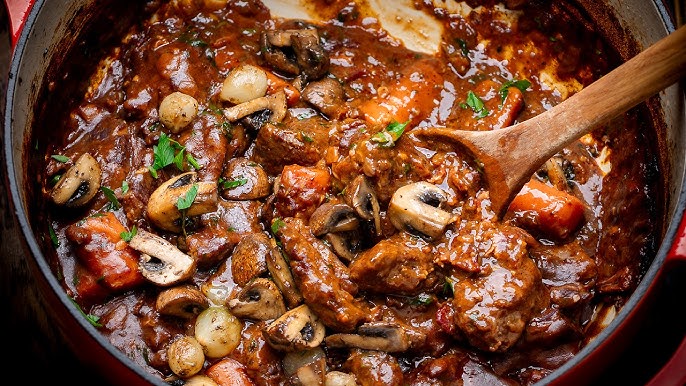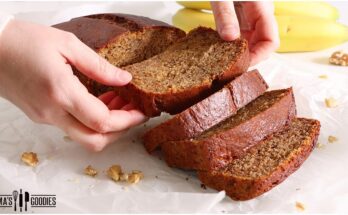Beef Soup Recipe: There’s nothing like a bowl of warm beef soup to soothe your soul on a chilly day. Packed with tender beef, hearty vegetables, and rich flavors, it’s a timeless comfort meal that has been enjoyed across various cultures for generations. Whether you’re battling a cold, looking for a nourishing dinner, or simply craving a taste of home, beef soup delivers every time.
Why Beef Soup is a Perfect Comfort Meal
The combination of tender, slow-cooked beef and vegetables creates a dish that fills you up without feeling too heavy. The steaming hot broth has a way of calming both your stomach and your mind, making it a favorite for cold weather or recovery days. Plus, the aroma of beef soup simmering on the stove can instantly make your house feel more inviting and cozy.
Nutritional Benefits of Beef Soup
Beef soup isn’t just tasty; it’s also incredibly nutritious. Rich in protein, vitamins, and minerals like iron and zinc, it supports muscle repair and boosts your immune system. When prepared with homemade broth, beef soup can also provide collagen and other nutrients that support joint and skin health. The inclusion of vegetables only enhances these benefits, giving you a balanced meal in every bowl.
Ingredients Needed for Beef Soup
Making beef soup from scratch is easier than you think. Here’s a breakdown of what you’ll need:
Main Ingredients
- Beef: Use a cut like chuck roast, beef shank, or short ribs for a rich, meaty flavor.
- Vegetables: Carrots, potatoes, celery, and onions are classic choices.
- Broth: Beef or vegetable broth serves as the base for the soup.
- Aromatics: Garlic, bay leaves, and herbs like thyme or parsley to enhance flavor.
Optional Ingredients for Extra Flavor
- Tomatoes: Add diced tomatoes or tomato paste for a tangy depth.
- Spices: Crushed red pepper flakes for heat or cumin for a smoky touch.
- Noodles or Rice: Perfect if you want a heartier meal.
Ingredient Preparation Tips
- Chop your vegetables evenly to ensure they cook at the same rate.
- Cut the beef into bite-sized chunks, trimming excess fat.
- Use fresh herbs for the best flavor, but dried herbs work in a pinch.
Step-by-Step Instructions to Make Beef Soup
Let’s walk through the process of making beef soup, step by step:
Step 1: Gather and Prepare the Ingredients
Before you begin cooking, gather all the ingredients and prep them accordingly. This includes washing and cutting your vegetables, trimming and cubing the beef, and measuring out any herbs, spices, and broth.
Step 2: Sauté the Aromatics
In a large pot or Dutch oven, heat a bit of oil over medium heat. Add diced onions, minced garlic, and any other aromatics (like celery or bay leaves). Sauté for about 5 minutes, or until the onions turn translucent and fragrant.
Step 3: Brown the Beef
Next, increase the heat to medium-high and add the beef to the pot. Brown the meat on all sides to lock in the flavor. This step is crucial for building a deep, savory base for your soup.
Step 4: Add Vegetables and Broth
Once the beef is browned, add your chopped vegetables to the pot. Pour in enough broth to fully cover the ingredients. Bring the mixture to a boil, then reduce the heat to low.
Step 5: Simmer the Soup to Perfection
Cover the pot with a lid and let the soup simmer for 1 to 2 hours. The slow simmering process allows the beef to become tender and infuses the broth with rich flavors. Stir occasionally and skim off any foam or excess fat that rises to the top.
Step 6: Season and Adjust Flavor
Taste your soup and adjust the seasonings as needed. Add salt, pepper, or other spices to your liking. If the soup needs more acidity, a splash of vinegar or lemon juice can do wonders.
Different Variations of Beef Soup
There are endless ways to customize beef soup. Here are a few popular variations:
Classic Beef and Vegetable Soup
This version sticks to the basics, with beef, carrots, potatoes, onions, and celery in a savory broth. It’s simple, hearty, and always satisfying.
Spicy Mexican Beef Soup (Caldo de Res)
Caldo de Res features beef bones, corn on the cob, and squash, with a slightly spicy and tangy broth. Garnish it with lime, cilantro, and jalapeños for an authentic touch.
Asian-Inspired Beef Noodle Soup
For a twist, try an Asian-style beef soup. This version often includes ingredients like ginger, soy sauce, and rice noodles, with a light yet flavorful broth.
Tips and Tricks for the Best Beef Soup
Making the perfect beef soup involves a few key techniques:
Choosing the Right Cut of Beef
Select cuts with some marbling, like chuck or short ribs. These cuts become tender and flavorful when slow-cooked. Avoid lean cuts like sirloin, which can turn tough and dry.
How to Achieve a Rich, Flavorful Broth
Browning the beef and aromatics at the start creates a flavorful foundation. For an even richer broth, consider adding a splash of red wine or Worcestershire sauce.
Balancing Herbs and Spices
Experiment with fresh and dried herbs to find the right balance. Remember, herbs like thyme and bay leaves add depth, while fresh parsley or cilantro brightens the finished dish.
How to Serve and Store Beef Soup
Once your beef soup is ready, you’ll want to know how to serve it and what to do with any leftovers. Proper storage and reheating ensure that the flavors stay fresh and delicious.
Serving Suggestions
- Fresh Bread: Serve your beef soup with crusty bread or dinner rolls to soak up the flavorful broth.
- Garnishes: Add freshly chopped parsley, a sprinkle of grated parmesan, or a squeeze of lemon juice for extra flavor.
- Side Dishes: You can also serve the soup with a simple green salad or roasted vegetables for a balanced meal.
- Pairings: Red wines like Merlot or Cabernet Sauvignon complement the rich flavors of beef soup beautifully.
Storing Leftover Soup
- Let the soup cool to room temperature before storing.
- Transfer it to airtight containers and refrigerate for up to 4 days.
- If you want to store it for longer, freeze the soup in freezer-safe containers or bags. It can last up to 3 months in the freezer.
Reheating Tips
- Reheat the soup on the stovetop over medium heat, stirring occasionally.
- If reheating from frozen, thaw it in the refrigerator overnight before warming it on the stove.
- Avoid boiling the soup, as this can overcook the vegetables and alter the texture.
Common Mistakes to Avoid When Making Beef Soup
Even experienced cooks can make mistakes when preparing beef soup. Avoid these common pitfalls to ensure the best results.
Overcooking the Vegetables
Nobody likes mushy vegetables. Add hard vegetables (like carrots and potatoes) early, but reserve softer ones (like green beans or spinach) for the last 10-15 minutes of cooking.
Not Browning the Beef Properly
Skipping the browning step is a major mistake. Browning caramelizes the meat’s surface, which enhances the flavor of the broth. Take the time to brown your beef on all sides.
Using Low-Quality Broth
The broth is the backbone of your soup. If you’re using store-bought broth, go for a high-quality brand with no added preservatives. Better yet, make your own beef broth for the richest flavor.
Health Benefits of Homemade Beef Soup
When you make beef soup from scratch, you control the ingredients, which means it’s both nutritious and delicious.
Supports Immune Health
Homemade beef soup is rich in immune-boosting nutrients like zinc, vitamin A, and vitamin C (from vegetables). It’s especially comforting when you’re feeling under the weather.
Provides Essential Vitamins and Minerals
Beef is an excellent source of iron, which helps prevent anemia and keeps your energy levels high. The soup also contains potassium and magnesium, which support heart health and muscle function.
Aids Digestion and Gut Health
Slow-cooked broth, especially if made with bones, is rich in gelatin and collagen. These nutrients support gut health by improving the lining of your stomach and intestines. This makes beef soup a great option for those with digestive issues.
FAQs about Beef Soup Recipe
1. What are the best cuts of beef for soup?
For beef soup, tougher cuts that benefit from slow cooking are ideal. Chuck, brisket, or short ribs offer rich flavor and tender texture after simmering.
2. How long should I cook beef soup?
Cooking time varies depending on the cut of beef. Generally, beef soup should simmer for at least 1.5 to 2 hours to ensure the meat is tender and the flavors are well-blended.
3. Can I make beef soup in a slow cooker?
Yes, beef soup is excellent when made in a slow cooker. Set your cooker on low for 6-8 hours or on high for 3-4 hours to achieve tender, flavorful meat.
4. What vegetables go well in beef soup?
Common vegetables include carrots, potatoes, onions, celery, and peas. You can also add green beans, corn, or diced tomatoes for more variety.
5. Is beef soup healthy?
Beef soup can be a hearty and nutritious meal, providing a good source of protein, vitamins, and minerals. Use lean cuts of beef and plenty of vegetables for a healthier option.
6. How can I thicken beef soup?
To thicken beef soup, mix a tablespoon of cornstarch or flour with water and stir it into the soup. Allow it to simmer for a few minutes until the desired consistency is reached.
7. Can beef soup be frozen?
Yes, beef soup freezes well. Cool the soup completely, then store it in airtight containers. It can be kept frozen for up to 3 months.
8. What herbs and spices work well in beef soup?
Bay leaves, thyme, rosemary, and parsley are excellent choices. For a kick of flavor, consider adding paprika or a dash of cayenne pepper.



